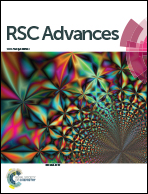The Aharonov–Bohm effect in the carbon nanotube ring
Abstract
The Aharonov–Bohm oscillations of the energy gap and the persistent current in carbon nanotube rings (CNTRs) are investigated theoretically. By considering the rotational symmetry about the axis of CNTRs, we construct a tight-binding model for CNTRs under a magnetic flux (MF) Φ. The Φ-dependent energy gap and persistent current are calculated when the bond lengths are different between the outer atoms and inner atoms. We find that all CNTRs are semiconductors and that zigzag CNTRs exhibit paramagnetism at small magnetic flux Φ in contrast with the diamagnetism of armchair CNTRs. In addition, the effect of the vortex magnetic flux (VMF) on CNTRs is studied. The persistent current is periodic in a VMF Φθ with the same period fluxon Φ0 as in a MF Φ. Furthermore, the VMF is more effective at tuning the energy gaps of the CNTRs than the MF.


 Please wait while we load your content...
Please wait while we load your content...